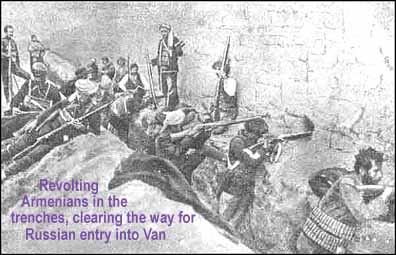|
|
... With only 127
rifles. A shining example of the objectivity used by The New York Times (at
least when it comes to Turkish matters) may be found in the following account.
|
|
|
| BEAT
OFF 4,000 TURKS |
--------------------------------------------------------------------------------
Armenian Refugees on Mount Moses Had Only 127 Rifles..
--------------------------------------------------------------------------------
MARCH 12, 1916
Details of their defense against the Turkish troops and their escape ever the rugged paths
of Mount Moses were given yesterday by Ohannes Klijeian, one of the forty-five Armenian
refugees who arrived Friday on the Royal Italian steamship America. Most of these refugees
have been discharged from Ellis
Island and the majority of them have gone to various places in Pennsylvania, where
arrangements have been made for them to obtain employment.
"Our decision to fight the Turks," said Klijeian, "was reached by watching
the fate of other Armenians. We had seen them sent off to exile, then had heard of the
terrible persecution they suffered and of their murder. Each village was notified that its
inhabitants must make ready to go. Our time came. We held secret meetings, we realized
that we were going to certain and horrible death, and, knowing that resistance could not
be worse, decided to fight to the last.
"It was on Aug. 5 that four villages, of which my own home, Bityas, was one, united
their populations. There were 618 from my village and a few more than 4,000 in all. When
the Turks learned that we had gone up into Mousa Dagh (Mount Moses) 200 soldiers were sent
after us. We had 127 rifles, some old shotguns and horse pistols. We had reached the upper
crags of the mountain and had had time to dig hasty trenches and roll large rocks
together, making the best barricade we could. The Turks attacked us, suffered severe
losses, and were driven back.
"Then they made arrangements for a more general attack, dragging up two field guns,
which wrought havoc in our ranks. Peter Gragosian, a boy of 14, crept down through the
brushwood and among the rocks. He was so close he could hear the Turks talking. With five
bullets he killed four gunners.
"The Turks were bent on reaching us, and 4,000 strong, succeeded in having a part of
their troops occupy high ground threatening our camp. Reinforcements kept coming up the
mountain, and we knew something must be done. There was a hurried council of our leaders
to meet what we knew was the crisis. As a result of the council our men crept around the
Turkish positions in the dead of night, closed in suddenly with a fuallade, and it
succeeded, for in a few moments the Turkish camp was thrown into bewilderment and alarm,
and the troops, thinking it a much more substantial attack than it was, broke and fled in
all directions.
"Then followed many days of ???lety and hardship. They kept coming after us and we
defended ourselves as best we could. We had captured some guns and ammunition from the
Turks, which we used against them."
Later, as THE NEW YORK TIMES has told, the women among these refugees made a huge white
flag, with a red cross in the center, the display of which on the mountain brought French
warships to the rescue.
Taken from an Armenian
web site, where there were tons of other similarly slanted New York Times
articles. The image below is not from The Times' report, and it is meant
only as a depiction; it is not a photograph.

Holdwater says: I liked the part about
the crack shot kid: "Peter Gragosian, a boy of 14, crept down through the
brushwood and among the rocks. He was so close he could hear the Turks talking. With five
bullets he killed four gunners."
So let's see... Talat Pasha's assassin, Soghoman Tehlirian, admitted in his trial that he first faced his victim, then walked past him to shoot
Talat in the back of the head. Armenian terrorists
murdered many Turkish diplomats, their families and others in the 1970s-80s, when their
victims couldn't see the bullets or bombs coming. In the early part of the 1990s, Armenia
attacked Azerbaijan in a "Pearl Harbor" type of unannounced sneak attack,
slaughtering many unarmed citizens.
Is it just me, or do you also see a pattern emerging, of the noble Armenian fighting
style?
As a point of interest, Vahan M. Kurkjian wrote in "A History of Armenia"
(1958): "Remarkable was also the epic of the 4000 Armenians
of Moussa-Dagh, who from the heights of this mountain drove back the Turkish
assaults until they were rescued by French battleships."
In contrast to the implication of the Times report, perhaps the Armenians were not
so heavily outnumbered against the "4,000 strong" Turks.
|
For the whole story behind Musa Dagh
|
|